PEOPLE
2-10 depending on the size of the team. If it becomes larger than 10 people consider breaking out into smaller groups.
TIME
30-60 Minutes. No one wants to be in a meeting longer than needed. Try to keep it short and sweet.
NINJA LEVEL
Novice to Master. Anyone can facilitate a successful lessons learned meeting!
PREP WORK
PEOPLE
This is key to successful meetings. Make sure all key stakeholders and team members are on the invite.
PLACE
Virtually or in-person it is critical that everyone has face-time with each other. So make sure that if attending virtually that everyone can connect in video chat. You will also need to share ideas, so a whiteboard is important and a space that fosters creativity and innovation.
THE PLAY
All of our plays are five steps or less! However, you may need to run multiple plays to get the most out of this one. Don’t worry – you can do it! Learn the play, rehearse it regularly, apply it in the field and debrief on the outcomes. If it worked well, use it again; if it didn’t, find out why. Are there new factors in the system you need to consider, or do you just need to keep practicing? If you need help or have questions on this play, contact us!
01
SET THE STAGE
Who are the players?
Every winning team knows which players to have on the field and what talent you need on the ready. This play requires any team member who was part of the project. To successfully deploy this play you will need the following roster:
![]() Meeting Facilitator: Likely this is you! But you don’t have to do it alone, ask a friend (think of it like a football team that has a coach for different parts of the team). Skills needed:
Meeting Facilitator: Likely this is you! But you don’t have to do it alone, ask a friend (think of it like a football team that has a coach for different parts of the team). Skills needed:
- Keep the team focused on the goal!
- Foster a positive and creative space for all
- Organized and prepared to run play
![]() Sponsor: This must be someone who has skin in the game. In sports this would be the team owner, someone who has an investment in seeing the team win. In business this is typically a project sponsor or product owner who charters the project. Skills needed:
Sponsor: This must be someone who has skin in the game. In sports this would be the team owner, someone who has an investment in seeing the team win. In business this is typically a project sponsor or product owner who charters the project. Skills needed:
- Authority to fund the project and team
- Engaged in outcomes and supporting the team
- Biggest supporter in the stands
![]() Product/System/Business Unit Owners: These are decision makers. They can make the call on what changes will happen or authorize a strategy. In some businesses they might be dual roles and also sponsor the project. Skills needed:
Product/System/Business Unit Owners: These are decision makers. They can make the call on what changes will happen or authorize a strategy. In some businesses they might be dual roles and also sponsor the project. Skills needed:
- Change agent. Supportive and enthusiastic about improvements.
- Supportive of the team and SMEs!
- Committed and engaged in the project all the way to the end.
![]() Stakeholders: Key members of the team who can help drive direction of the final product. This can be internal or external players. They might have a specialized skill set but they are interested in being part of the winning team. For the initial meeting this does not need to include the entire team, but be sure that each group has representation. Skills needed:
Stakeholders: Key members of the team who can help drive direction of the final product. This can be internal or external players. They might have a specialized skill set but they are interested in being part of the winning team. For the initial meeting this does not need to include the entire team, but be sure that each group has representation. Skills needed:
- Vested interest in the outcome
- Commitment to seeing it through completion (no fair weather fans)
- Engaged and believes the team can win!
![]() Subject Matter Experts (SMEs): A SME (pronounced S-Mee) is critical for this play. They will help drive the team to a shared understanding of what is needed to win. Skills needed:
Subject Matter Experts (SMEs): A SME (pronounced S-Mee) is critical for this play. They will help drive the team to a shared understanding of what is needed to win. Skills needed:
- Specific domain knowledge, narrow and deep rather than broad and shallow.
- Communication and team collaboration. They must be able to share with others the knowledge they have on a particular subject.
![]() Solution Architect: This person is in charge of leading the practice of designing, describing, and managing the solution engineering in relation to specific business problems. Skills needed:
Solution Architect: This person is in charge of leading the practice of designing, describing, and managing the solution engineering in relation to specific business problems. Skills needed:
- Finding the best tech solution among all possible to solve the existing business problems.
- Describing the structure, characteristics, behavior, and other aspects of software to project stakeholders.
- Defining features, phases, and solution requirements.
- Providing specifications according to which the solution is defined, managed, and delivered.
![]() Builders: This can be any implementation resource. They will take the requirements and specifications as guidance on what to build. They are team players. In sports, they are the players out on the field. Skills needed:
Builders: This can be any implementation resource. They will take the requirements and specifications as guidance on what to build. They are team players. In sports, they are the players out on the field. Skills needed:
- Is the 3R’s: Responsible, Reliable and Ready
- Communicate effectively.
- Optimistic and future-focused.
- Shows genuine commitment.
- Supports and respects others.
- Embraces collaboration.
- Actively listens.
- Problem solver.
![]() Team Players: This is someone who actively contributes to the team in order to complete tasks, meet goals or manage projects. Team players aim to improve the product or process at hand. Every organization relies on good teams. Skills needed:
Team Players: This is someone who actively contributes to the team in order to complete tasks, meet goals or manage projects. Team players aim to improve the product or process at hand. Every organization relies on good teams. Skills needed:
- Communicate effectively.
- Is the 3R’s: Responsible, Reliable and Ready
- Optimistic and future-focused.
- Shows genuine commitment.
- Supports and respects others.
- Embraces collaboration.
- Actively listens.
- Problem solver.
Get the field ready!
![]() Schedule the meeting in advance. Don’t wait until the last minute to schedule the meeting. You want people to be excited about it but not so last minute that they have no time to prepare.
Schedule the meeting in advance. Don’t wait until the last minute to schedule the meeting. You want people to be excited about it but not so last minute that they have no time to prepare.
![]() Include an agenda. Set expectations – this will help keep your meeting on track. Include schedule and any prep work needed. Also let them know if it is okay to invite others or not. Remember that if you have to many people in the meeting, it will be difficult to facilitate brainstorming sessions without breaking out into smaller groups.
Include an agenda. Set expectations – this will help keep your meeting on track. Include schedule and any prep work needed. Also let them know if it is okay to invite others or not. Remember that if you have to many people in the meeting, it will be difficult to facilitate brainstorming sessions without breaking out into smaller groups.
![]() Prep the room. Arrive early and get ready. If it is in a physical room, get whiteboards ready, enough chairs for everyone, water and snacks are always a hit! If virtually, a central location for notes, brainstorms and follow-up items. Test connectivity in the meeting room and make sure there is enough seats for all participants.
Prep the room. Arrive early and get ready. If it is in a physical room, get whiteboards ready, enough chairs for everyone, water and snacks are always a hit! If virtually, a central location for notes, brainstorms and follow-up items. Test connectivity in the meeting room and make sure there is enough seats for all participants.
02
CORE ACTIVITIES
TEAM INTRODUCTION
Some of the team members may not have directly worked with others during the project. This is a nice time to highlight their contribution to the project and role in the team.
- Start by introducing yourself, and what your role was on the project team:
- Who you are in the organization and how long you have been in this role
- Your contributions/highlights on the project
- Move around the group and have each person introduce themselves answering the same questions
REWIND
Go back to the notes from the Project Kick-off meeting. Review with the team what the original objective and key results were for the project.
Confirm with the team that the objective and key results were known and shared to all members frequently. If not, note opportunity on how to improve shared understanding of project objective and key results.
MILESTONES (KEY RESULTS)
This is a focused discussion on timeline. Great teams always are on the look out for how to improve. Review estimates and actuals on task/milestone completion. This is not an exercise of blame, rather opportunities for optimization.
Ask the team:
- Without sacrificing quality, what is one way we could complete this faster?
- If cost were fixed/constrained as well, what could we do to be more efficient?
THE GOOD, THE BAD & THE UGLY
This is the section that most are familiar with in a lessons learned meeting. However, most teams just jump into this without much prep. For this to be meaningful the team must feel that they can speak freely and that the environment is safe to do so. Otherwise, you will get a lot of awkward silence. Set ground rules:
- Respect one another and assume positive intent. Remind the team that the goal is to have candid conversations but should come from a place of caring about one another. Everyone has a right to their opinion, but no one has a right to be hurtful with it. Speak from a space of respect towards one another.
- Speak from a viewpoint of “I” rather than “you”. I think __________, or It is my opinion __________, or In my experience ___________, or I see an opportunity __________. Don’t speak for others and avoid speaking at someone. This type of “I” speak is being accountable for your own actions rather than presenting as judgement of others.
- Be truthful and authentic. If something didn’t go right, own it. It will build credibility in the team and people will respect your opinion on how to fix it. This is not the space for word play or perception management. The team needs to understand how to improve and we have to start from a place of truth to do so.
Now you are ready to begin the discussion around what went well, what could be improved and what did we learn. You have to decide how to record the results. In a small group you might just enter the feedback in an Excel sheet. With a larger audience, you might choose to use white boards and sticky notes where team members record their thoughts. Irrespective of the tool you always use a 3 column structure:
- column 1 = what went well,
- column 2 = what didn’t go well and
- column 3 = learnings.
Review feedback with the team and keep any lengthy/tangent conversation on a parking lot board for offline follow-up.
SHOUT-OUT
Thank the team for their participation in the lessons learned activity but also in the project. Open it up for shout-outs of team members for positive contributions. Shout-outs should be:
- Specific and calls out the person by name
- Short and sweet
- Positive
This helps end the meeting on a positive note!
Want to learn more about the power of a shout-out? Check out this article from lendio.com
03
 TEAM HUDDLE
TEAM HUDDLE
Time to run the Team Huddle play. Ask the team the following questions and then take a vote. Keep follow-up questions to a minimum and capture any issues raised as an offline follow-up (and be sure to follow-up).
Understand the play?
![]() The play was understood and I asked any questions in time!
The play was understood and I asked any questions in time!
![]() I’m not sure I understand and I have some questions …
I’m not sure I understand and I have some questions …
![]() I did not understand the play or my part in it.
I did not understand the play or my part in it.
Did you get in the game?
![]() Yes, I made my moves and was in the right place at the right time!
Yes, I made my moves and was in the right place at the right time!
![]() I’m not sure I understand what I was supposed to do …
I’m not sure I understand what I was supposed to do …
![]() I kept the bench warm and watched from the sidelines.
I kept the bench warm and watched from the sidelines.
Ready for what’s next?
![]() Yes, I know the game plan and ready to win!
Yes, I know the game plan and ready to win!
![]() I’m not sure what’s next or if I am involved …
I’m not sure what’s next or if I am involved …
![]() No clue what’s next and would rather sit it out.
No clue what’s next and would rather sit it out.
04
NEXT STEPS
Congratulate the team on a very successful and productive lessons learned meeting!

![]() If needed, schedule another meeting. For large projects you may need to repeat this meeting several times to identify all lessons learned. Don’t worry, once the team gets the hang of it, the next meeting(s) will go much faster and smoother.
If needed, schedule another meeting. For large projects you may need to repeat this meeting several times to identify all lessons learned. Don’t worry, once the team gets the hang of it, the next meeting(s) will go much faster and smoother.
![]() Publish your notes in a central repository that the team has access to immediately. Even better if it is someplace that the team can add comments or collaborate on. Keep the creative chat going!
Publish your notes in a central repository that the team has access to immediately. Even better if it is someplace that the team can add comments or collaborate on. Keep the creative chat going!
05
IT’S A WRAP
You did it! Now just a few follow-up items:
- Reflect on the play. Ask yourself how it went? What could have gone better, what could have gone worse? In sports this is watching the game again to see any plays that could have been better. Update your playbook. Build feedback loops that help you see what’s working; what’s not; and how to continue to develop the playbook by learning, adapting and iterating constantly as situations change and new challenges arise.
- Contribute to the community of Playbook.Ninja. Sign-up for an account and receive updates on when new plays are added and help others by commenting on the plays with what worked or your experience.
Thank you for being a Playbook.Ninja
![]()


 TEAM HUDDLE
TEAM HUDDLE